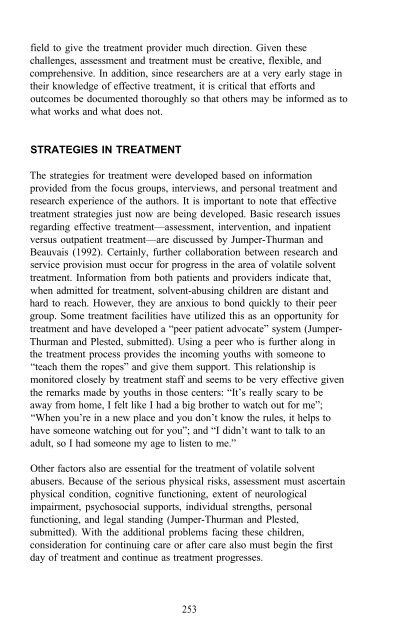Epidemiology of Inhalant Abuse - Archives - National Institute on ...
Epidemiology of Inhalant Abuse - Archives - National Institute on ...
Epidemiology of Inhalant Abuse - Archives - National Institute on ...
Create successful ePaper yourself
Turn your PDF publications into a flip-book with our unique Google optimized e-Paper software.
field to give the treatment provider much directi<strong>on</strong>. Given these<br />
challenges, assessment and treatment must be creative, flexible, and<br />
comprehensive. In additi<strong>on</strong>, since researchers are at a very early stage in<br />
their knowledge <str<strong>on</strong>g>of</str<strong>on</strong>g> effective treatment, it is critical that efforts and<br />
outcomes be documented thoroughly so that others may be informed as to<br />
what works and what does not.<br />
STRATEGIES IN TREATMENT<br />
The strategies for treatment were developed based <strong>on</strong> informati<strong>on</strong><br />
provided from the focus groups, interviews, and pers<strong>on</strong>al treatment and<br />
research experience <str<strong>on</strong>g>of</str<strong>on</strong>g> the authors. It is important to note that effective<br />
treatment strategies just now are being developed. Basic research issues<br />
regarding effective treatment—assessment, interventi<strong>on</strong>, and inpatient<br />
versus outpatient treatment—are discussed by Jumper-Thurman and<br />
Beauvais (1992). Certainly, further collaborati<strong>on</strong> between research and<br />
service provisi<strong>on</strong> must occur for progress in the area <str<strong>on</strong>g>of</str<strong>on</strong>g> volatile solvent<br />
treatment. Informati<strong>on</strong> from both patients and providers indicate that,<br />
when admitted for treatment, solvent-abusing children are distant and<br />
hard to reach. However, they are anxious to b<strong>on</strong>d quickly to their peer<br />
group. Some treatment facilities have utilized this as an opportunity for<br />
treatment and have developed a “peer patient advocate” system (Jumper-<br />
Thurman and Plested, submitted). Using a peer who is further al<strong>on</strong>g in<br />
the treatment process provides the incoming youths with some<strong>on</strong>e to<br />
“teach them the ropes” and give them support. This relati<strong>on</strong>ship is<br />
m<strong>on</strong>itored closely by treatment staff and seems to be very effective given<br />
the remarks made by youths in those centers: “It’s really scary to be<br />
away from home, I felt like I had a big brother to watch out for me”;<br />
“When you’re in a new place and you d<strong>on</strong>’t know the rules, it helps to<br />
have some<strong>on</strong>e watching out for you”; and “I didn’t want to talk to an<br />
adult, so I had some<strong>on</strong>e my age to listen to me.”<br />
Other factors also are essential for the treatment <str<strong>on</strong>g>of</str<strong>on</strong>g> volatile solvent<br />
abusers. Because <str<strong>on</strong>g>of</str<strong>on</strong>g> the serious physical risks, assessment must ascertain<br />
physical c<strong>on</strong>diti<strong>on</strong>, cognitive functi<strong>on</strong>ing, extent <str<strong>on</strong>g>of</str<strong>on</strong>g> neurological<br />
impairment, psychosocial supports, individual strengths, pers<strong>on</strong>al<br />
functi<strong>on</strong>ing, and legal standing (Jumper-Thurman and Plested,<br />
submitted). With the additi<strong>on</strong>al problems facing these children,<br />
c<strong>on</strong>siderati<strong>on</strong> for c<strong>on</strong>tinuing care or after care also must begin the first<br />
day <str<strong>on</strong>g>of</str<strong>on</strong>g> treatment and c<strong>on</strong>tinue as treatment progresses.<br />
253
















